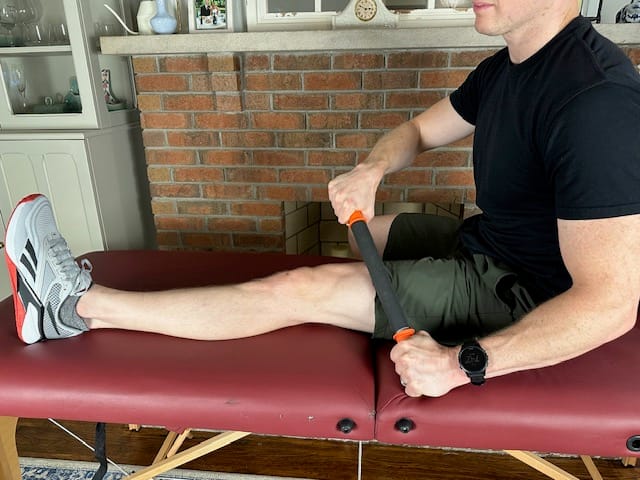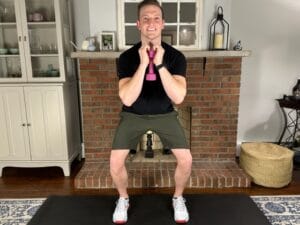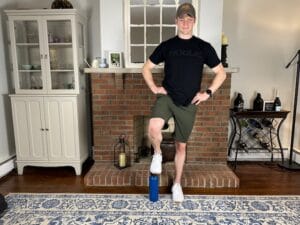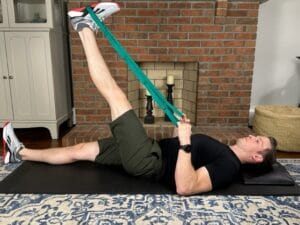Looking for the Best Exercises for Quadriceps Strain?
If you’re dealing with a quadriceps strain, you’re probably feeling tight, sore, and unsure about how to move without making things worse. This guide is here to help you reduce pain, improve mobility, and start rebuilding strength — safely and at home.
These exercises are based on clinical best practices and real-world rehab results, all from my years of experience treating patients. We’ll break them down into two phases: early recovery (0–3 weeks) and strength building (3–6 weeks). Everything here is safe for at-home rehab, assuming you’ve been cleared by your healthcare provider.
Before we dive in, consider checking out our related rehab guides:
- Exercises for Patellar Tendinitis
- Best Patellofemoral Pain Syndrome Exercises
- Distal IT Band Exercises to Reduce Pain
Let’s start with the early phase after quad strain— where the goal is to protect healing tissue, gently restore motion, and activate your quad without overloading it.
Want a quick-reference PDF? Scroll down to the bottom of this post to grab your free printable plan!
Disclaimers and Disclosures: All information in this article is for informational and educational purposes only and should not be taken as individual medical advice. Additionally, this article contains affiliate links, meaning when you make a purchase, we make a small commission at no additional cost to you. For more information, see our full Disclaimers and Disclosures.
Phase 1 (0–3) Weeks: Early Pulled Quad Muscle Recovery Phase
In this early phase, our main focus is to:
- Control pain and inflammation
- Begin gentle range of motion
- Activate the quadriceps without excessive strain
These foundational exercises are designed to gently restore movement while protecting healing tissue. They’re based on real clinical protocols and are safe for most mild-to-moderate quad strains.
Perform these exercises 1–2 times per day, only if pain stays mild and controlled.
This program was created by a Doctor of Physical Therapy and Orthopedic Clinical Specialist. As always, consult your healthcare provider before starting any new exercise regimen.
1. Heel Slides
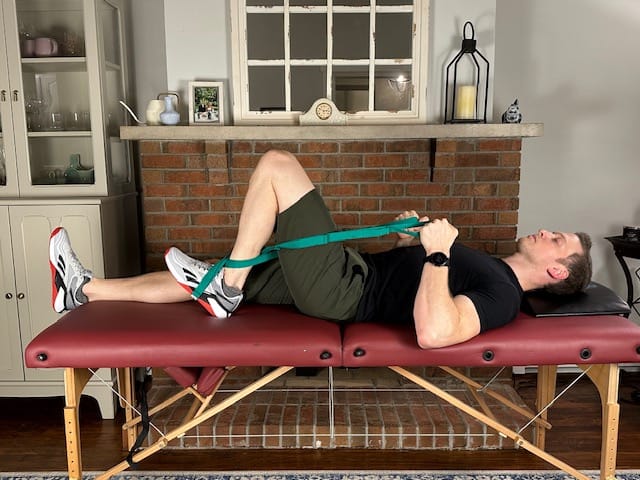
- Purpose: Gently stretches the quad muscle and restores flexion range of motion.
- Benefits: Prevents stiffness and encourages muscle/fascia movement and healing.
- How to Do It:
- Loop a strap around your foot.
- Slide your heel slowly toward your buttocks, keeping your foot on the surface.
- Hold for 10 seconds and repeat 10 times.
- Pro Tip: Use a Stretching Strap with loops for ease and for the best results.
2. Short Arc Quad
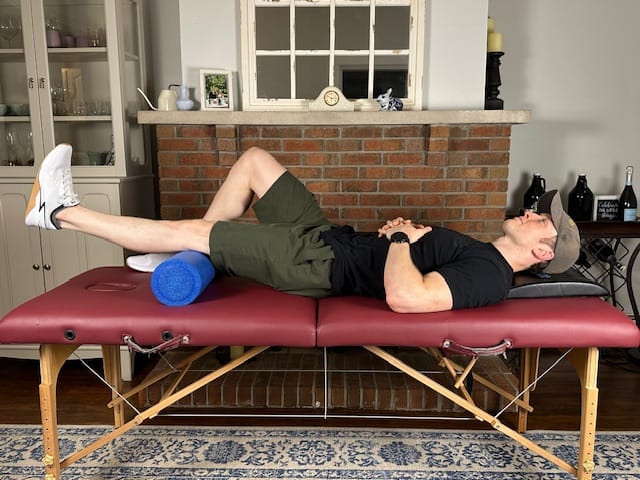
- Purpose: Gently activates the quad muscle through a small range of motion.
- Benefits: Supports muscle firing without excessive aggravation.
- How to Do It:
- Rest your knee over a foam roll while lying on your back.
- Straighten the knee by lifting your heel off the surface, pause briefly at the top.
- Lower slowly and repeat 20 times for 2 sets.
- Pro Tip: Use Ankle Weights for added resistance and a Foam Roll for proper support.
3. Long Arc Quad
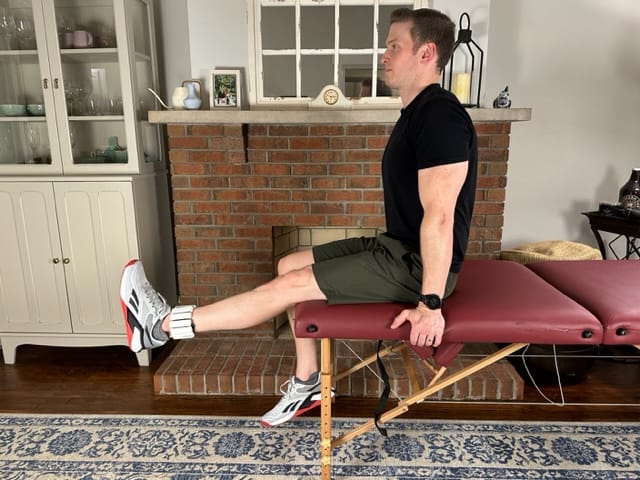
- Purpose: Strengthens the quadriceps through a full, controlled range.
- Benefits: Improves muscle control and knee extension.
- How to Do It:
- Sit upright with your thigh supported.
- Slowly extend your leg fully, hold briefly, then lower.
- Perform 20 reps, complete 2 sets.
- Pro Tip: Use Ankle Weights to increase resistance and muscular activation slowly.
4. Straight Leg Raise
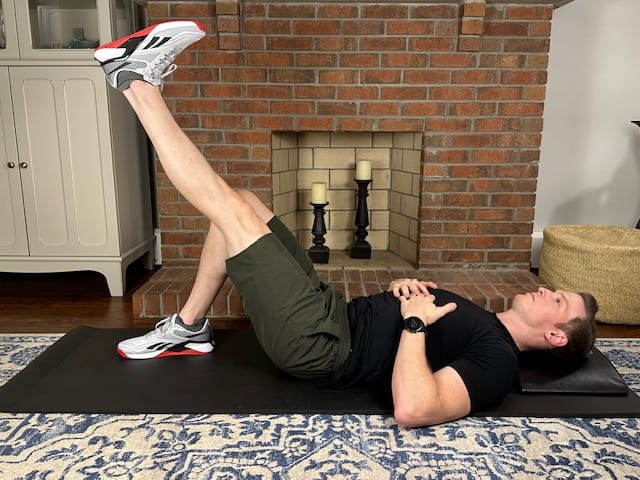
- Purpose: Activates the quadriceps without knee movement.
- Benefits: Builds strength and reduces atrophy with a pulled quad muscle.
- How to Do It:
- Lie on your back with one leg bent and the other straight.
- Tighten your thigh and lift the straight leg to the height of your bent knee, then lower slowly.
- Repeat for 10 reps and complete 2 sets..
- Pro Tip: A Thick Foam Mat helps reduce pressure on your hips and spine during floor exercises.
5. Sidelying Clams
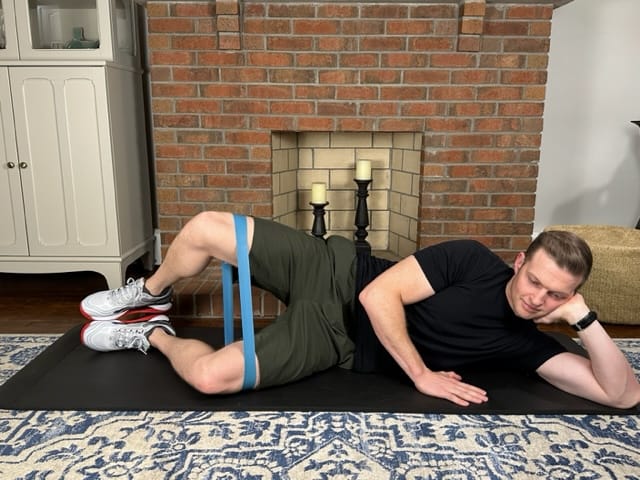
- Purpose: Activates the glute medius muscle on the outside of the hip.
- Benefits: Improves hip stability and supports knee alignment.
- How to Do It:
- Lie on your side with knees bent and loop a band around your knees.
- Keep feet together and open your top knee like a clamshell, pause for 3 seconds.
- Perform 10 reps, and complete 2 sets.
- Pro Tip: Start with a light Resistance Band and slowly tension over the weeks.
6. Soft Tissue Massage (Foam Roller)
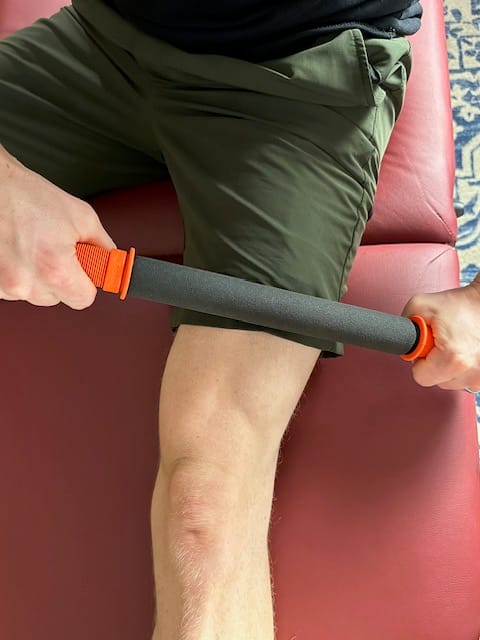
- Purpose: Reduces muscle tightness, helps proper formation of healing tissue.
- Benefits: Promotes circulation and muscle relaxation, along with pain reduction.
- How to Do It:
- Sit with your leg extended.
- Roll slowly over the quad for 2–3 minutes.
- Focus on tight or sore spots.
- Pro Tip: Use a Foam Roller for ease of use and proper control of pressure.
Bonus: Ice Pack and TENS for Quad Strain Pain and Swelling
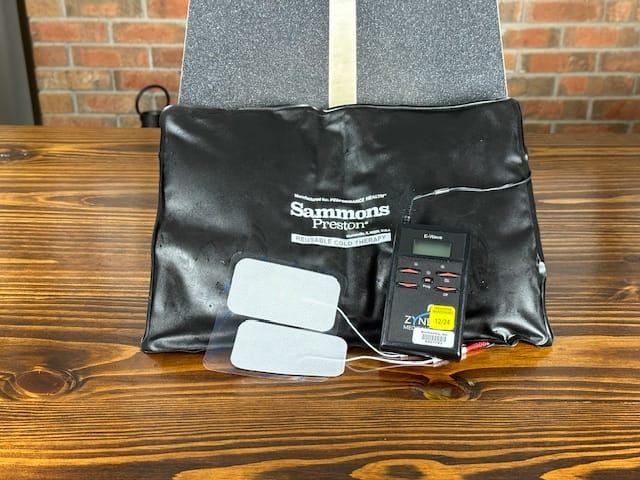
- Purpose: Reduce pain, inflammation, and muscle inhibition during early recovery.
- Benefits: Enhances comfort and reduces swelling, especially after exercise.
- How to Use:
- Place TENS pads just over the painful area of the quad.
- Apply ice for 10–15 minutes post-exercise.
- Pro Tip: Get a small, portable TENS Unit and wrap the Ice Packs in a pillowcase to protect the skin.
Phase 2 (3-6) Weeks: Strength and Control Phase Exercises for a Quadriceps Strain
Now that tissue healing is underway, it’s time to focus on:
- Improving hip and quad strength
- Restoring movement control
- Building tolerance to daily activities
This next phase emphasizes controlled loading to support a return to walking, stairs, and light sport-specific movements. It’s important to progress gradually to avoid re-injury.
Perform these exercises 5-7 times per week, with couple rest days along the way where you do your exercises from phase 1.
This program was created by a Doctor of Physical Therapy and Orthopedic Clinical Specialist. As always, consult your healthcare provider before starting any new exercise regimen.
1. Bridges with Band
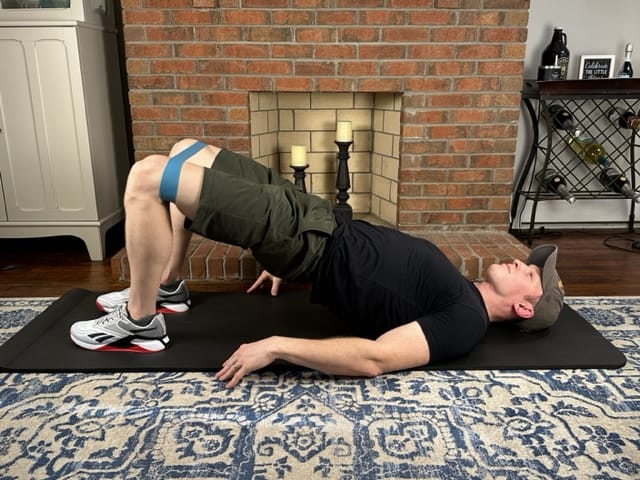
- Purpose: Strengthens glutes and hamstrings with mild tension on the quad.
- Benefits: Improves hip extension and core stability, while isometrically strengthening the quad.
- How to Do It:
- Lie on your back with knees bent and band above knees.
- Squeeze glutes and lift hips off the floor, hold for 2 seconds at the top.
- Perform 15 repetitions and complete 2 sets.
- Pro Tip: Get a pack of loop Resistance Bands for easiest use and progression.
2. Sidesteps with Band
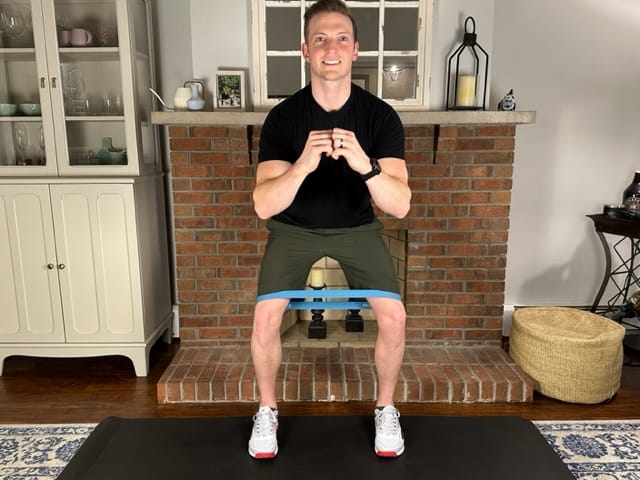
- Purpose: Activates glute medius and lateral hip muscles to improve stability.
- Benefits: Enhances dynamic stability and knee alignment.
- How to Do It:
- Place a resistance band just above your knees and lower into a mini squat.
- Step sideways slowly, keeping tension in the band.
- Perform 12-15 steps in each direction, rest, and repeat 3 times.
- Pro Tip: Start with a light Resistance Band and progress slowly, this one is tougher than it looks.
3. Step-Ups (Forward)
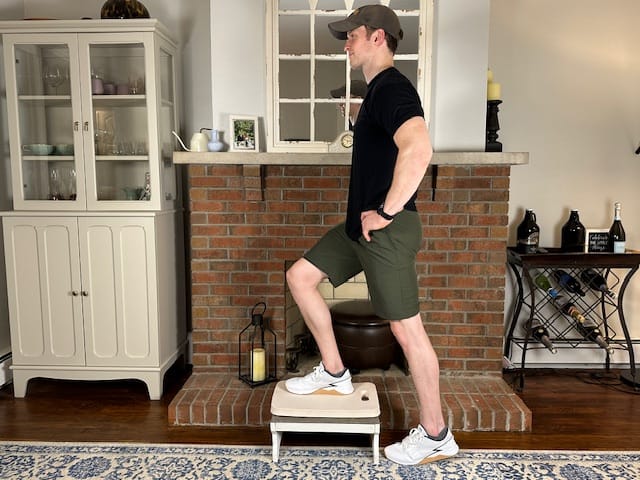
- Purpose: Builds quad strength through a functional motion.
- Benefits: Prepares for stairs, walking, and standing movements.
- How to Do It:
- Stand in front of a step with a counter nearby for balance.
- Step up with your injured leg, then lower with control.
- Repeat on the other side, perform 10 reps, complete 2 sets.
- Pro Tip: Use an Adjustable Stepper and start at 4 inches and slowly increase the height as the movement gets easier.
4. Lateral Step-Overs
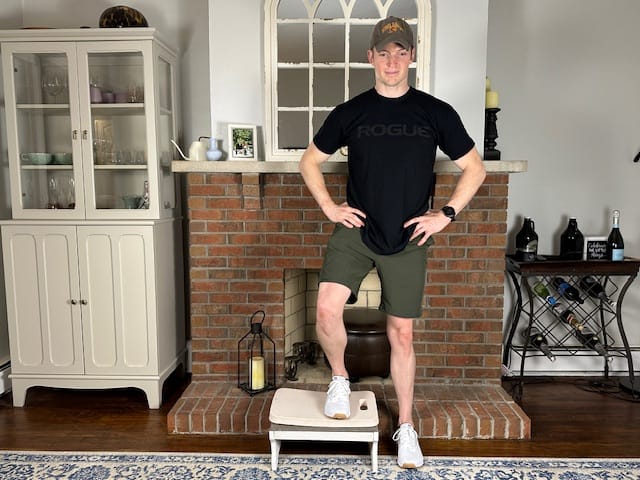
- Purpose: Enhances coordination and eccentric quadriceps control.
- Benefits: Improves stability and prepares for lateral movement in sport and life.
- How to Do It:
- Stand beside the step and step laterally up with your outer leg.
- Bring the other leg up, then step down to the other side.
- Return to start in the same fashion, complete 10 reps and perform 2 sets.
- Pro Tip: Focus on knee alignment as you go over the Adjustable Step, don’t let it collapse inward.
5. Single Leg RDL (Romanian Deadlift)
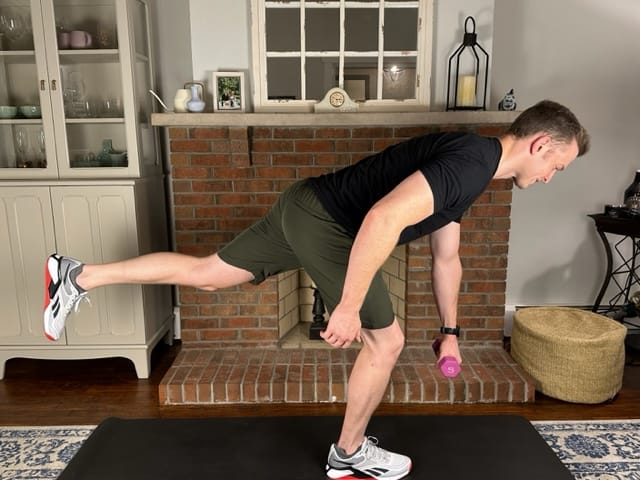
- Purpose: Strengthens the hamstrings, glutes, and core while challenging dynamic balance.
- Benefits: Reinforces hip stability and reduces re-injury risk.
- How to Do It:
- Stand on your injured leg and hold a light weight in the opposite hand.
- Hinge at the hips, extending the free leg back as the weight lowers.
- Return to upright by squeezing your glutes and hamstrings. Complete 2 sets of 10 reps.
- Pro Tip: When the movement gets easy, hold a Dumbbell Weight for a greater challenge.
6. Goblet Squats
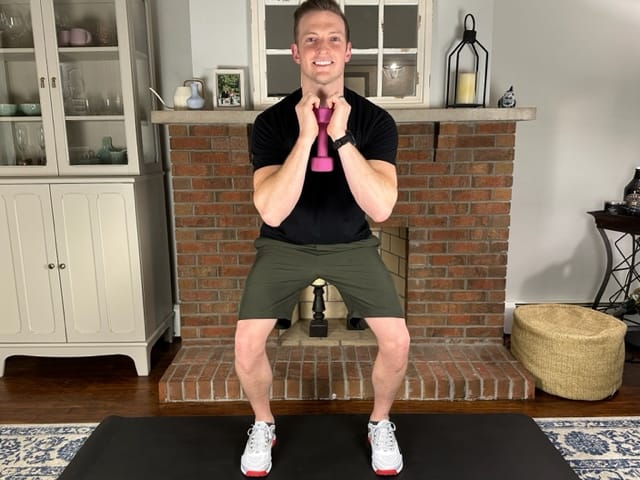
- Purpose: Builds compound strength in quads, glutes, and core in a functional movement pattern.
- Benefits: Improves squat mechanics, knee control, and lower body power.
- How to Do It:
- Hold a dumbbell close to your chest with elbows down.
- Squat down slowly, keeping your chest tall and knees aligned.
- Press through your heels to return to standing 10 times, complete 2 sets.
- Pro Tip: Slowly increase the Dumbbell Weight over time to build more strength.
7. Prone Quad Stretch with Strap
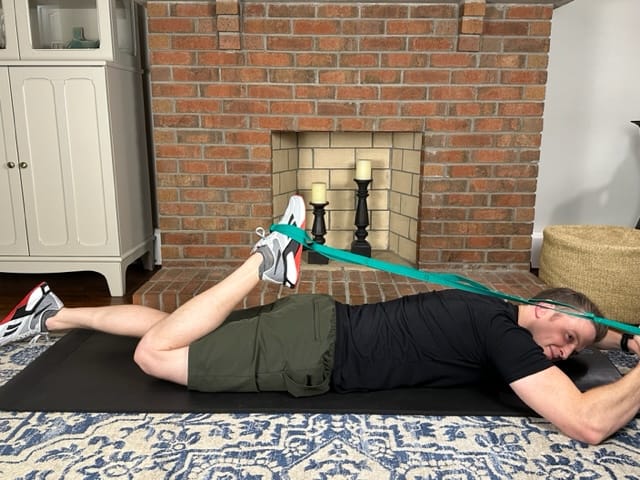
- Purpose: Is a more aggressive stretch of the quadriceps to help return it to normal length.
- Benefits: Improves knee bending and reduces anterior thigh tightness.
- How to Do It:
- Lie on your stomach and loop a strap around your ankle.
- Gently pull until you feel a stretch in the front of your thigh.
- Hold for 10 seconds, repeat 10 times.
- Pro Tip: Start gentle and use a Stretching Strap with loops to create a lasso around your ankle to control the stretch
Looking for a simple way to stay consistent?
👉 Download the free full Quadriceps Strain Exercise Program + Exercise Tracker (PDF) to follow and log your daily progress.
Best Exercises for Quadriceps Strain: Final Thoughts
A quadriceps strain can disrupt your routine and make even simple movements uncomfortable—but early, consistent rehab can accelerate healing and prevent setbacks. The key is following a structured progression of exercises that rebuild strength, restore motion, and gradually reintroduce load to the healing tissue.
This program was designed by a physical therapist to guide you through the first six weeks of recovery with safe, effective movements you can do at home. These exercises target the quads and supporting muscles, helping reduce pain, improve control, and get you back to walking, stairs, and daily life with confidence.
Stay consistent, listen to your body, and don’t push through sharp pain. With steady progress, you’ll likely see noticeable gains in strength, mobility, and function—all without needing fancy equipment or a gym membership.
Why Trust Physical Therapy Simplified for Quadriceps Strain Rehab Exercises?
At Physical Therapy Simplified, our mission is to provide an accessible, trustworthy source of physical therapy guidance that anyone can understand, follow, and benefit from. We want you to feel confident that you’re getting evidence-based advice and the best exercises after quadriceps strain—all designed to reduce pain and restore your highest functional potential.
This article was written by Andrew Harkins, PT, DPT, OCS, a licensed physical therapist with over twelve years of clinical experience. He is certified by the American Board of Physical Therapy Specialties as an Orthopedic Clinical Specialist and has successfully helped hundreds of patients recover from quadriceps strains and return to sports, work, and daily activity with strength and confidence.
Andrew has also served as a teaching assistant at the University of Pittsburgh’s Doctor of Physical Therapy Program, where he contributed to musculoskeletal rehab education with an emphasis on lower extremity injuries like quad strains, knee tendinopathies, and post-surgical protocols. His knowledge and hands-on experience ensure that the information you’re reading is not only accurate but clinically proven to help.
